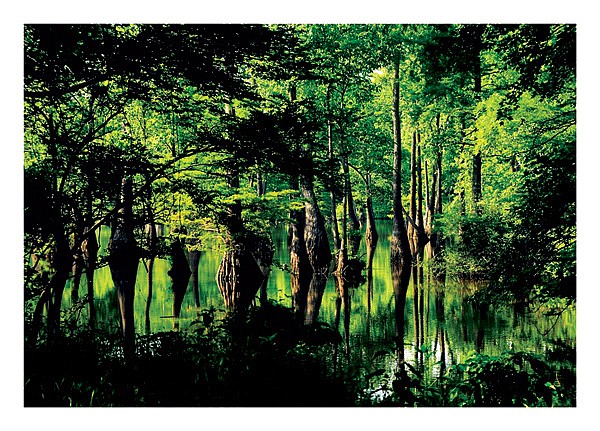Journey Through Time
Photographer rides White River to its heart
This cyprus swamp — Apple Lake — drains into the Cash River, which drains into the White River. It’s become one of photographer Chris Engholm’s favorite spots on his White River journey.
Friday, January 4, 2013
Chris Engholm might seem like the last guy you’d find floating down the White River.
The California native spent the “dot-com” years as a software engineer. He was a real estate developer in the boom days of the early 2000s.
He’s written several books on “business with a cultural bent” and taught self-help seminars based on his writings.
All of those things made his living, he says. His life was about photography and creative writing.
That’s not what brought him to Northwest Arkansas, but he found a significant art and cultural project after he arrived. He and wife Elizabeth had been in Guatemala, studying the Mayan people who live around Lake Atitlan, when they decided to follow a family member - and a “whim” - and move to the Ozarks. They found a house and three acres online and drove in from Mexico during the blizzard of 2010 with no warm clothes - only to find they had no electricity and no stove, either, and “couldn’t even see the driveway.”
It was an inauspicious beginning. But they soon fell in love, not just with the acreage near Bentonville, where their twin 10-year-olds “turned into Tom Sawyer and Huck Finn down in the river every day,” but with the “up and coming art community.” They put together “Guardians Of Spirit,” an exhibit based on their Mayan experiences, and debuted at Studio 124 in Bentonville.
“That was kind of our coming-out here in town,” Engholm says.
At the gallery, he met Eve Smith, visual arts director atthe Arts Center of the Ozarks, which explains why “White River Memoirs” will be showcased at ACO in January.
How it became a multimedia record of life along the White River is a whole different story.
“At the same time I met Eve, I started to get involved with the Shiloh Museum of Ozark History,” he explains. “Allyn Lord, the director, and I started talking about the fact that the White River, which I had become enamored with, wasn’t well documented culturally or environmentally. We stumbled on to the idea of an oral history, and we got a grant that has allowed me to interview 35 people from the headwaters down to the Mississippi.
“Then I thought that I should meet those people in their own surroundings, and I decided in a naive way that I would float down the river.”
Engholm has since covered about 550 of the White River’s 700 miles, and “I have confirmed that the story that is walking around in people’s heads is really a quality collective memory of a greatnatural resource.”
Along the way, he also met artists, writers and photographers who had spent lifetimes capturing the White River in all its glory, and he invited them to be part of the exhibition, adding a wealth of history to the project.
One of them was Turner G.
Browne, who in the early 1990s photographed the people who then lived on houseboats on the lower White River.
Another was Gayne Preller Schmidt from Augusta, Ark., not an artist herself but keeper of a collection of photos shot by her grandfather, Hugo Arthur Preller, and his wife, Gayne.
“Hugo Preller did a lot of famous historical pictures along the river,” Engholm says.
“He lived in what was called ‘the floating gallery,’ people who traveled in houseboats down the Mississippi and up the White River. He did a lot of photography of African-American people who worked as sharecroppers in that area - very important photographs historically.”
Engholm also discovered that Gayne had done most of the Prellers’ early studio work, making her perhaps “the earliest important female photographer in the state.”
At the reception Thursday at ACO, Engholm will unveil several canvas enlargements of photographs from the Preller archive. Also on display will be a vintage john boat as well as what he calls “a true treasure” - a tackle box full of mint fishing gear from the 1960s’70s.
Visitors will also view about an hour of video Engholm shot along his journey - a chance to vicariously travel the White River, see the sights and hear the sounds.
“I just kept the camera rolling as the landscape changed,” he says.
The originally conceived result of his journey - a manuscript titled “White River Memoirs: The Spoken History of a Liquid Legend” - will be available for purchase at the reception and will become part of the Shiloh Museum’s collection as well.
Whats Up, Pages 15 on 01/04/2013
